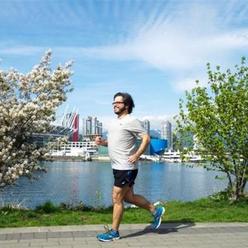This detailed infographic, published by The Spine and Sports Health Centre, provides several running facts and figures. It also covers some of the most common orthopaedic injuries’ signs and symptoms.

Transcript: Running Facts and Figures
Run: [ruhn]
adjective
To go quickly by moving the legs more rapidly than at a walk; and in such a manner that for an instant in each step, all or both feet are off the ground.
Burn, Baby Burn
- Running burns 50% more calories than walking.
- If you weighed 150 lbs., a 20-minute walk would burn about 85 calories, while a 20-minute run would burn about 225 calories.
- In order to burn off a Big Mac, a 140 lb. female would have to run 52 minutes at a 10 minute per mile pace.
- If you ran around the circumference of the earth (24,901 miles), at 145 lbs., you’d burn 2,357,751 calories.
- Unfortunately, runners can only store about 2,000 calories worth of glycogen in their bodies—enough to fuel about 118-20 miles of running.
Put Your Heart Into It
- When we run, the human heart creates enough pressure to squirt blood thirty feet.
- In a study presented in 2010, running a marathon can result in decreased function of more than half the segments in the heart’s main pumping camber—fortunately, other parts of the heart take over. Full recovery is reached within three months or less. The more fit a runner, the less of an effect.
- Just thinking about exercise causes heart rate to increase in anticipation of an increased need for energy.
About the Body
- It takes 200 muscles to take a step.
- Your feet contain about 25,000 sweat glands that can collectively produce a pint of sweat a day.
- During a 10-mile run, your feet hit the ground at a force of three or four times you body weight. So in other words, if you weigh around 200 lbs., every time you run, your feet feel like you transformed into a cow.
Injuries
- Women are four times more likely to have foot injuries than men, mostly to the lifelong pattern of wearing high heels.
- 75% of Americans will experience foot health problems of varying degrees at some point.
- Adult runners who played ball sports through their youth had 50% fewer stress fractures than runners who didn’t. In addition those runners who played ball sports had a greater and more symmetrically distributed bone mass.
TOP 5 Most Common Injuries Among Runners
IT Band Syndrome
- Symptom: Pain in the side of the knee.
- Cause: Overuse, tight tissues, poor running form.
Plantar Fasciitis
- Symptom: Pain in your heel or the bottom of the foot.
- Cause: Over-training, or improper worn-out footwear.
Runner’s Knee
- Symptom: Pain around or behind the kneecap.
- Cause: Running on uneven surfaces, to inadequate shoes, to muscle weakness.
Achilles Tendinitis
- Symptom: Pain at the back of the lower leg.
- Cause: Tight calf muscles, lack of flexibility.
Shin Splints
- Symptom: Aching pain in the front of the lower leg.
- Cause: Running on hard surfaces, exercising with worn out footwear.









